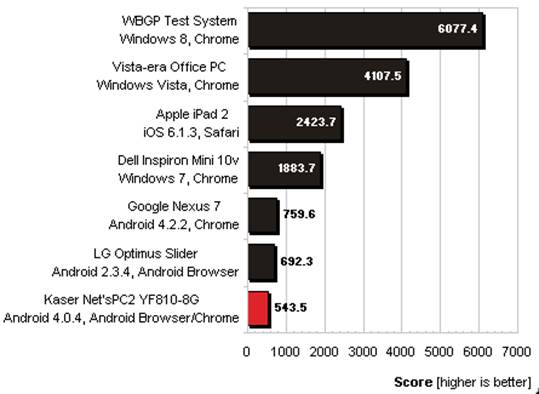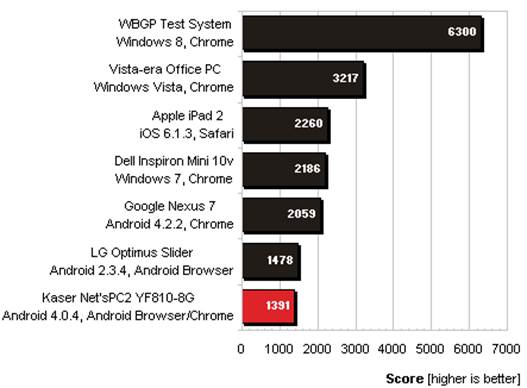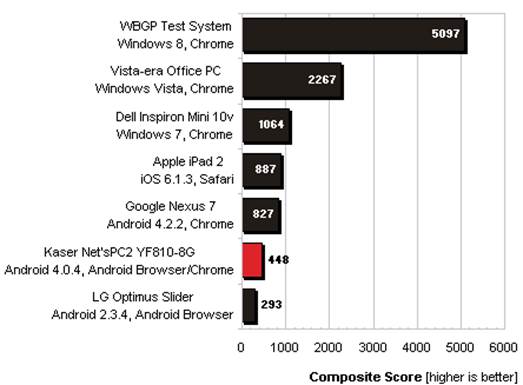Web test: Diet WBGP!
The web tests consist of a group of
selected tests from our Web Browser Grand Prix series/ to compare for these
articles, we include the results from the normal Core i5-based WBGP system into
these charts. While at first we want to include an approximately $1,000 PC to
all of tests at present, its score makes all other bars in the graphics and
system diagrams become small clots that are almost invisible. Fortunately,
inclusion of WBGP system in the web test doesn’t create any problem.
To show all systems in the best possible
light, we have chosen the fastest browser for each OS. In case of PC and Nexus
7, it will be Chrome, while iPad 2 uses Safari. As LG Optimus S based on Android
2.3 can’t run Chrome, available Android Browser is still the best bet. However,
Kaser is a strange circumstance. Though it’s able to install Chrome, we know
the available Android browser is faster in performing the current websites,
while Chrome is good at the next generation web pages. So, to give this weak
product an actual opportunity to fight, we’re testing Kaser by using the
available Android Browser mixture and Chrome. While Dolphin with add-on JetPack
is the fastest browser for Android technically, we support the second, Chrome, to
make the device/PC comparison becomes more balanced.
Our first test is BrowsingBench of EEMBC. We
choose this test as it measures what can be considered as the most impressive
respect of web browsing: loading page time for the real time web pages. This
test doesn’t have the experimental techs which many current web tests
concentrates on. Instead of that, it tests some common but normal HTML4/CCS2 website
from all over the world.

Our
first test is BrowsingBench of EEMBC.
It’s predictable that the WBGP testing
system ranks first, following by office Vista-aged PC. While we knew that the
first generation netbooks offer the experience that is below the standard,
we’re surprised to see iPad 2 beat Dell Mini 10v in such resounding way.
Ranking below Atom-based Nettop is Nexus 7 of Google, following by LG Optimus
S. even when using the existing Android browser instead of Chrome, Kaser still
at the bottommost, falling behind $50 Optimus S in almost 200 scores. If we use
Chrome in this test, the score of Kaser will lower down to 2 digits.
Next is BrowserMark of Rightware, a page render
test checks some respects of the browsing performance, including: CSS, DOM, page
load time, WebGL, HTML5 Canvas, and JavaScript.

Next
is BrowserMark of Rightware, a page render test checks some respects of the
browsing performance
The position of BrowserMark is the same to BrowsingBench’s,with
the only big differences being the leading gap for the WBGP testing system, a
closer gap between Dell Mini 10v and Apple iPad 2, and the score continues to
be significantly improved for Google Nexus 7.
Continue on to the more concentrated tests,
we have Peacekeeper of Futuremark, a JavaScript performance test.
The leading gap of the WBGP testing system
against the Athlon 64 X2-based computer increases remarkably. Meanwhile, iPad 2
falls from the 3rd position to 5th position, and finally Kaser
has beaten the prepaid smartphone pricing almost half.
Now let’s come to the next generation test,
with 2 HTML5 performance tests focusing on the very different tasks. First is WebXPRT
of Principled Technologies, a web-app test based on HTML5. This test reproduces
the common productivity-increasing tasks which are normally processed by the
internal installed apps, including: image editing, finance chart, and offline
noting.
The order here is still the same as on Peacekeeper,
with the 3 computers based on x86 pass the ARM-based rivals.
Finally, we have Impact HTML5 Benchmark, a
platform test based on regular HTML5.
In this test, Nexus 7 passes Mini 10v neck
to neck, breaking the x86 monopoly.
Now, let’s consider the geometric average
number of the score in 5 web-browsing tests.

Now,
let’s consider the geometric average number of the score in 5 web-browsing
tests.
The difference between price and
performance is incredibly amazing. While the $1,000 WBGP testing system is
worth with being 10 time the price of Kaser, we’re shocked by the 5 year-old
office PC being better than the more expensive ARM-based product. In another
surprise, Dell Mini 10v will first generation Atom processor has its own
position. Sitting right among the PC trio and the Android devices is iPad 2, which
follows closely to Mini 10v at the 3rd position rather than Nexus 7 sitting
at the 5th position. Using Android Browser in BrowsingBench allows Kaser
surpass LG phone, though if Kaser has run Chrome in that test, the score of
these 2 cheap-priced products will be identical basically.
Even with 2 browsing scenarios, Net’sPC2 can’t
prove that it’s cost twice the price of the prepaid Gingerbread phone (one more
time, not include the screen cost). Moreover, the Vista-era PC which has the
same price delivers about 5 times the web-browsing performance of Kaser.